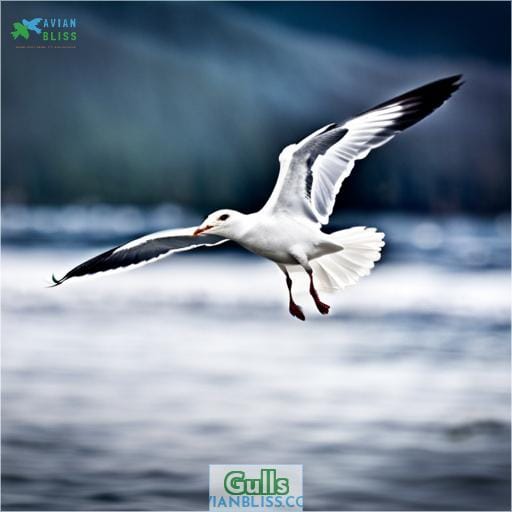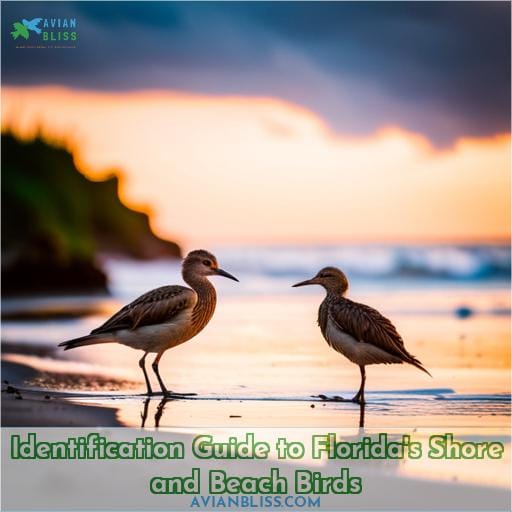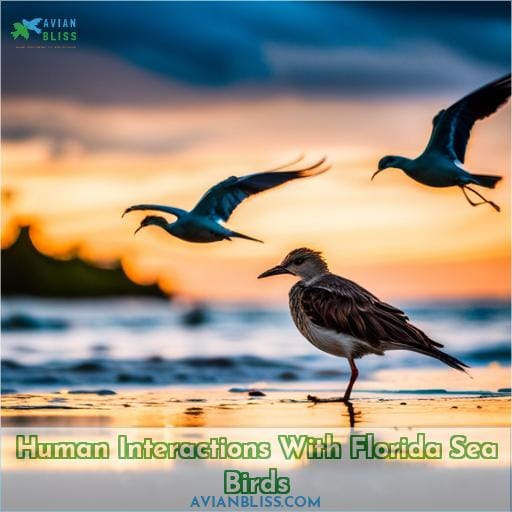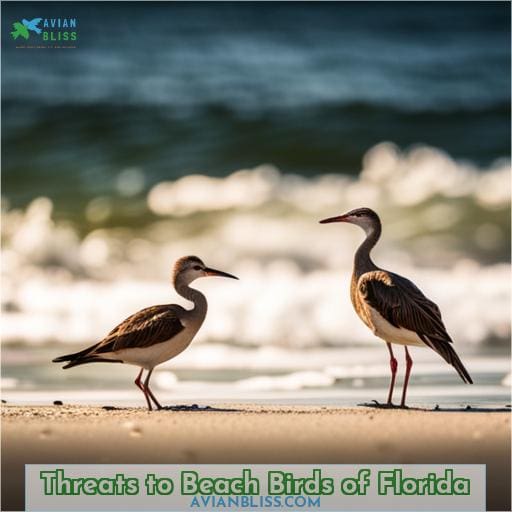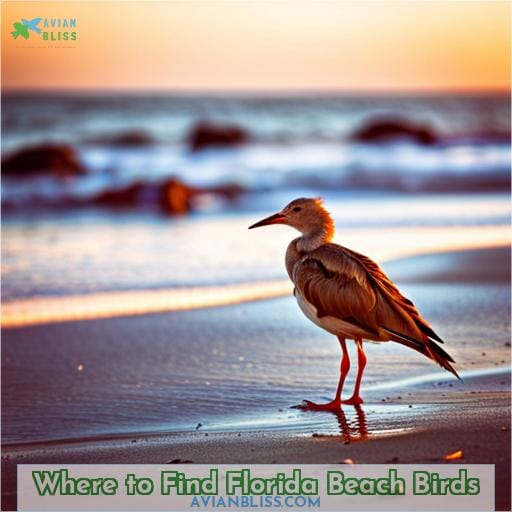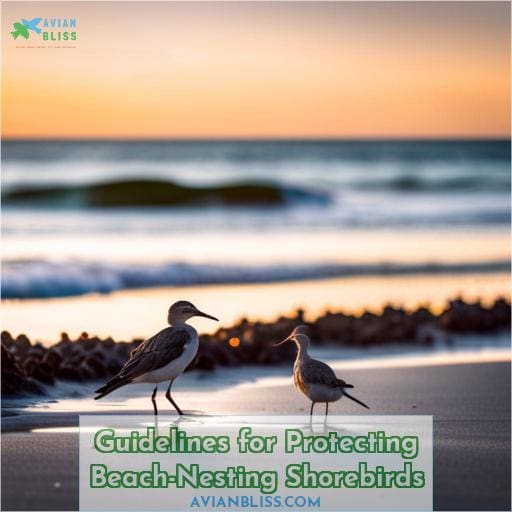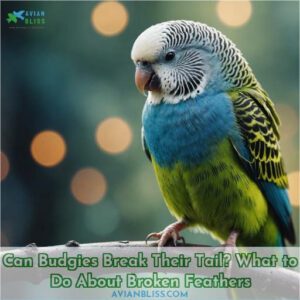This site is supported by our readers. We may earn a commission, at no cost to you, if you purchase through links.
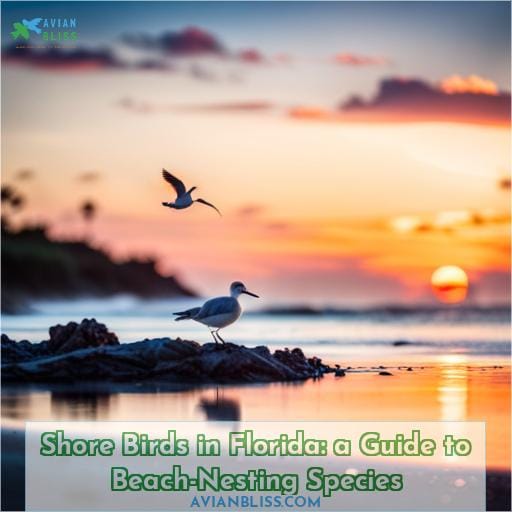 Come to Florida’s shorelines and behold the wonders of avian acrobatics! Shore birds, from gulls with black heads and red bills to terns in all their graceful glory, dance across the coastline.
Come to Florida’s shorelines and behold the wonders of avian acrobatics! Shore birds, from gulls with black heads and red bills to terns in all their graceful glory, dance across the coastline.
These feathered friends make beach-nesting a key part of their lifestyles – but what kinds are they?
Explore this guide for an introduction into Florida’s wonderful world of shorebird species so that you too can join in on recognizing these delightful creatures.
From laughing gulls to herring gulls, ring-billed gulls or even roof nesting waders; discover all about them here!
Get ready for a magical journey as we uncover every nuance behind why shore birds flock together along these sunny shores!
Table Of Contents
- Key Takeaways
- Types of Shorebirds in Florida
- Gulls
- Identification Guide to Florida’s Shore and Beach Birds
- Nesting and Migration of Shorebirds
- Human Interactions With Florida Sea Birds
- Threats to Beach Birds of Florida
- Where to Find Florida Beach Birds
- Guidelines for Protecting Beach-Nesting Shorebirds
- Shorebird Species in Florida (with Key Characteristics)
- Share Your Sightings of Shorebirds in Florida
- Conclusion
Key Takeaways
- Common shorebird species found in Florida include plovers, sandpipers, yellowlegs, dowitchers, and oystercatchers.
- Gull and tern species that inhabit Florida include herring gulls, ring-billed gulls, royal terns, and Caspian terns.
- Among the shorebirds in Florida, sanderlings, dowitchers, and willets play unique ecological roles.
- In addition to shorebirds, various wading birds such as herons, egrets, spoonbills, ibises, skimmers, and pelicans can also be found in the state.
Types of Shorebirds in Florida
You can see a variety of shorebirds when exploring Florida’s coastal habitats, from tiny Sanderlings scurrying on the beach to majestic Willets wading through the shallows. Common shorebirds include plovers, sandpipers, yellowlegs, dowitchers, and oystercatchers.
Their nesting habits vary, with some like Killdeer and Black-necked Stilts nesting on open beaches, while others nest in salt marsh grasses or scrubby dunes. Identifying tips include looking at size, bill shape, leg length, and plumage patterns.
Shorebirds undertake amazing seasonal migrations, some flying all the way to the Arctic! Conservation efforts aim to protect fragile beach habitats from disruption. Appreciating the diversity and resilience of these remarkable birds can inspire us to safeguard the places they depend on.
Gulls
Let’s discuss several key shorebirds you may encounter in Florida. As you explore the state’s coasts, keep an eye out for the graceful, fork-tailed terns along with small sanderlings scurrying along the sand.
Also watch for larger, long-billed dowitchers and gray willets poking along shorelines. You’ll certainly spot stately herons and egrets wading through wetlands and shallows too. While exploring the diverse habitats, observe the birds’ behaviors and take note of their distinguishing features.
With keen observation, you’ll soon be able to identify the avian residents and visitors that flock to Florida’s coasts.
Terns
In reference to terns, the two types often seen forked-tail flying along Florida’s coasts happen to be royal terns with orange bills and caspian terns having blood-red bills. Their migratory patterns have been well documented from nesting grounds in both the Northern and Southern Hemispheres.
While terns are closely related to gulls, they differ significantly with graceful flight and slender, pointed bills adept at spearing fish from the ocean surface. With many tern species threatened, habitat protection and reduced disturbance of nesting sites are critical to sustaining their populations, allowing people to continue enjoying these elegant coastal birds.
Sanderlings, Dowitchers, and Willets
Sanderlings scurry along the surf, probing for tasty tidbits, while dowitchers wade in the shallows, their sewing machine-like bills agape, and willets patrol the upper beach, ever vigilant for threats.
- Sanderlings run rapidly along the edge of the waves, pecking for morsels.
- Dowitchers migrate incredible distances from inland nests to coastal wintering grounds.
- Willets nest right on the open beach, requiring extensive protections.
The shorebirds all play unique roles along Florida beaches, enriching natural communities through their beauty and behaviors.
Herons and Egrets
Let’s shift gears to Florida’s elegant herons and egrets, known for their long legs, dagger-like bills, and patient stalking in shallow waters. Florida egrets and herons wade, wait, watch and strike to catch fish, frogs, crustaceans and insects.
Mangrove and coastal habitats support these sensitive birds. Safeguarding Florida wetlands through careful conservation connects us to these regal, adaptable feathered neighbors. Egrets and herons belong here as much as we do. Our responsibility: protect and respect.
Other Florida Beach Birds
You’ll see pink wading birds with spoon-shaped bills and elegant white ibises with red faces among other unique species along Florida’s beaches. The Roseate Spoonbill sweeps its bill side to side, foraging in shallow water. Conserve the White Ibis by protecting wetland habitat.
Watch for the Black Skimmer’s lower mandible cutting the water’s surface. Witness the American Oystercatcher probe shellfish with its bright orange bill.
In winter, look for pelicans soaring over the ocean or plunging for fish. Shorebirds depend on beaches for nesting and stopover sites during migration, so tread lightly. Threats include human disturbance, vehicles, predators, and habitat loss. With care, these birds will continue delighting beachgoers.
Identification Guide to Florida’s Shore and Beach Birds
Take a closer look at Florida’s shore and beach birds! You’ll find laughing gulls with black heads and red bills, larger herring gulls with white heads, ring-billed gulls with black rings on their yellow bills, brown pelicans with pouches, and statuesque great blue herons in shades of blue-gray.
The laughing gulls sport black heads paired with red bills while the bigger herring gulls don white heads. Keep an eye out for the ring-billed gulls’ distinctive black rings encircling their yellow beaks.
Brown pelicans can be identified by their characteristic pouches, and great blue herons cut a statuesque figure with their blue-gray plumage. Florida’s shores host a diverse array of bird species for avid birdwatchers to spot and admire.
Laughing Gulls
You’d notice the black hood and ruby beak of laughing gulls mingling fearlessly with people on the beach.
- Black hood that covers head and neck.
- Pointed red beak.
- Gray back and wings.
- White underside.
Laughing gulls stand out among shorebirds with their bold behavior, though feeding these opportunistic gulls requires caution.
Herring Gulls
You gaze in awe at the white-headed Herring Gull soaring majestically along the windswept beach. These large gulls breed in the Arctic but migrate south for winter. Look for their pale gray back, black wingtips, and yellow eyes.
They are omnivores, eating fish, invertebrates, eggs, and carion. Though still common, their numbers are declining. Aggressive around food, they may displace other seabords. Respecful observation of herring gulls reveals their adaptable nature.
Ring-billed Gulls
Seeing the black ring around their yellow bill, you’d think the ring-billed gulls were wearing tiny scuba masks as they dive for fish. Though similar to herring gulls, ring-bills are slightly smaller with more delicate features.
They breed in freshwater marshes across North America, migrating south for the winter. With large inland nesting colonies, their conservation status is of least concern; however, habitat loss continues to threaten these adaptable gulls that frequent beaches, parks, and landfills.
Pelicans
Encountering Brown Pelicans’ large brown feathers and sizable bags beneath their bills identifies them along Florida beaches. These magnificent birds soar above the waves then plunge headfirst to scoop up fish.
Though populations declined due to pesticides, the Brown Pelican has rebounded. Nesting on mangrove islands and beaches, they exhibit devotion to mates and young.
Great Blue Herons
When scanning the Florida shoreline, spotting a Great Blue Heron‘s gray-blue plumage and long neck clasped in an S-shape signals its presence as this large wading bird wades through shallows searching for fish.
As it stalks prey, listen for its deep croaking call. While nesting high in trees, these social herons form colonies with other waders like snowy egrets or roseate spoonbills. Conserving wetlands protects crucial feeding and nesting habitat for this majestic bird, often seen standing statue-still along Florida’s coasts and inland waterways.
Nesting and Migration of Shorebirds
You might find Florida’s beaches most alluring during the summer, but when it comes to observing shorebirds in their prime, it’s all about their annual life cycle of nesting and migration. From March to August, a variety of plovers, sandpipers, stilts, and oystercatchers flock to Florida’s shores to breed, often scrambling to lay and incubate eggs amid beachgoers before heading north to their Arctic breeding grounds.
Shorebirds Life Cycle
There is so much for you all to marvel at when these shorebirds nest and go about their life cycles along the coasts of Florida. The Lesser Yellowlegs, Willet, and Red Knot meticulously choose their nest sites.
But even optimal sites can’t eliminate all the risks. Predators are a constant threat. Some species migrate thousands of miles. Reproductive success varies. Factors like nest timing and habitat protection are key.
You all can make a difference by giving these birds adequate space and supporting coastal conservation.
Shorebirds Migration
You’ll observe shorebirds passing through Florida during migration between their breeding and wintering grounds. Many species follow the Atlantic Flyway or Mississippi Flyway. Some overwinter in Florida, while others continue to South America.
Tracking migration patterns helps target conservation efforts like preserving stopover habitats. The best birdwatching hotspots include St. Marks National Wildlife Refuge and Merritt Island National Wildlife Refuge.
Shorebirds display seasonal behaviors during migration—from courtship displays to feeding frenzies.
Shorebirds Nesting
Can’t overlook that every year over 100 shorebird species raise newly-hatched chicks along Florida’s coasts – relying on us to help protect their fragile nesting grounds from harm.
- Shorebirds nest on open sandy beaches and near coastal inlets.
- They lay their eggs in shallow scrapes or depressions in the sand.
- The parents take turns incubating the eggs and finding food for the hatchlings.
Viewing adorable fuzzy chicks scurrying on the beach is a joy. Yet we must tread lightly, keeping dogs leashed and respecting all posted nesting areas. With care, we can ensure the shorebirds return each season to continue their incredible migration journey.
Human Interactions With Florida Sea Birds
We must protect Florida’s birds by respecting their fragile nesting habitats and properly dealing with threats like litter and injuries. Observe posted closed areas, pick up trash that could endanger wildlife, and contact authorities immediately if you spot an injured bird to give it the best chance of survival.
The nesting habitats of Florida’s birds are fragile and must be respected. Litter and injuries threaten birds, so we must pick up trash and notify authorities if an injured bird is spotted.
Litter’s Impact on Birds
Improper disposal can harm the species you love. Seabirds often mistake plastic litter for food, frequently ingesting harmful debris. Participate in beach cleanups, properly dispose of trash, and avoid releasing balloons or plastic confetti outdoors.
Recycle fishing line and tackle to protect wildlife. By keeping beaches pristine through conservation efforts like limiting beach driving near nesting areas, together we enable shorebirds’ safe nesting and migration along our coasts.
Dealing With Injured Birds
Morbidly, the moment you find a deceased avian on the shores, wildlife rehabilitation centers implore you to contact the federal government posthaste.
- Contact nearby wildlife rehabilitation centers for help with injured birds. They can provide proper veterinary care and assist with rescue efforts.
- Avoid handling injured birds yourself unless trained in avian first aid. Even benevolent intentions could potentially harm them.
- Notify authorities regarding details such as species, injury location and description. Do not remove seemingly healthy fledglings from the wilderness. Allow specialists to determine if involvement is requisite. With attentive care and communal backing, injured avifauna frequently recuperate and get discharged.
Threats to Beach Birds of Florida
You’d help protect Florida’s vulnerable beach birds by keeping dogs leashed, trash contained, and staying clear of marked nesting zones.
These amazing avians face threats from human disturbance, nesting predators, and habitat loss. Even people just walking through can inadvertently harm fragile nests and cause parent birds to abandon their eggs.
Unleashed pets can harass and kill chicks. Trash attracts opportunistic predators like raccoons and rats.
Though challenges remain, conservation efforts have improved nesting success for species like Least Terns and Piping Plovers. With vigilance and care, we can safeguard the survival of these remarkable shorebirds for generations.
Simple actions like avoiding sensitive areas, properly containing waste, and keeping dogs controlled make a real difference. Together, we can ensure these spectacular seabirds continue gracing Florida’s shores.
Where to Find Florida Beach Birds
Beach-nesting shorebirds and other specialized birds can be found in great numbers along Florida’s coasts. The best places for beach birding include Gulf Islands National Seashore, Honeymoon Island State Park, Fort De Soto Park, Sanibel Island, Fort Myers Beach, Marco Island, Amelia Island’s Fort Clinch State Park, Merritt Island National Wildlife Refuge, and Everglades National Park.
Beach-Nesting Shorebirds
You’ll need to keep an eye out for these shorebirds along Florida’s sandy beaches.
- Nesting challenges.
- Conservation efforts.
- Human disturbance.
- Nesting buffer zones.
Rooftop nesting provides crucial habitat for nesting birds. We can all help protect beach-nesting shorebirds through education, responsible recreation, and keeping dogs leashed in nesting areas.
Notable Birding Locations
You can explore the Great Florida Birding & Wildlife Trail for the best spots to see shorebirds in Florida.
| Location | Highlight |
|---|---|
| Gulf Islands National Seashore | Beach, bay, and barrier island habitats along the Gulf Coast provide opportunities to observe many species. |
| Honeymoon Island State Park | A popular osprey nesting area with a beach perfect for spotting gulls, terns, and other coastal species. |
| Fort De Soto Park | Considered one of Florida’s premier birding destinations, attracting rare migrant species. |
| Sanibel Island | A renowned shelling location, Sanibel also boasts incredible bird diversity due to its variety of habitats. |
With abundant hotspots for birding and wildlife photography, festivals dedicated to birding, and extensive birding trails, Florida offers superb birdwatching opportunities.
Guidelines for Protecting Beach-Nesting Shorebirds
As a conservation biologist, I recommend staying mindful of Florida’s sensitive beach-nesting shorebirds as you explore the coast. Though coastal development has limited many species to protected areas where human activity is restricted, even minor disturbances – like an off-leash dog – can expose fragile nests and put breeding at risk.
So keep pets secured, properly dispose of trash to avoid attracting predators, avoid agitating clustered birds, and drive slowly on beaches, remaining vigilant since birds also nest on flat rooftops.
Coastal Development and Nesting Areas
Willets chicks scurry across the sand as construction vehicles rumble nearby. Pausing, they listen for mom’s familiar call. But the bulldozers edge closer, flattening dunes that protect nests from high tides and predators.
Though intended for recreation, poorly planned coastal development destroys irreplaceable habitat. We must respect nesting zones, monitor buffers, and curb unchecked building to preserve what little beach remains for the birds.
Together we can balance development and conservation by limiting construction in sensitive areas during nesting season.
Human Disturbance and Nest Exposure
Just one dog sprinting around nesting birds can send them into a panic, leaving their eggs exposed. Keep your pup on a leash and stay well away. Let the birds be; this beach belongs to them. Shorebirds need undisturbed stretches of coast to raise their chicks. Kite flying, vehicles, and pets spell trouble for nesting birds.
Watch where you walk, drive, and play. Give beach birds the peace and freedom they need.
Dog and Cat Restrictions
Keep your dog leashed and your cat inside to prevent disturbing nesting shorebirds. Sensitive birds instinctively flee from unrestrained pets, exposing vulnerable chicks and eggs. Follow beach pet policies for wildlife’s sake. Limit roaming to protect precious birds.
Your responsible actions safeguard the future of threatened shorebirds. Thoughtful pet care enhances beach conservation.
Trash Disposal and Predators
You’d attract fewer hungry predators by tossing trash in covered bins. Ferreting out proper disposal spots keeps critters from foraging in litter. Securing trash protects small chicks hunkered in the sand. Join beach cleanups to rally the local community in preserving nesting grounds.
Lead by example – stash trash neatly and urge others to follow suit. Our community can make each beach safer for the birds if we work together.
Kite Flying and Aggravated Birds
You must flee the sky when the birds become distressed. Kite flying risks driving nesting shorebirds into a panic. Agitated bird behavior signals to vacate airspace immediately. Respect wildlife by ceasing kite activities if seabirds exhibit agitation.
We share the coastline’s fragile ecosystems. With care and mindfulness of beach etiquette, together we can enable thriving shorebird conservation.
Rooftop Nesting and Beach Driving
Don’t forget the critical shorebird nests on rooftops as you cruise the beaches, because even a quick spin could doom their future. Many shorebirds now nest up high to avoid the ruckus below. But beach traffic still stresses them out.
Give nesting zones a wide berth when driving, stay under 15 mph, and avoid spinning wheels. Working together to minimize disturbance is key from sharing rooftop habitat to driving responsibly on beaches.
We can make a difference for these remarkable birds through understanding and compassion.
Shorebird Species in Florida (with Key Characteristics)
Dontcha gotta watch for those Semipalmated Plovers flittin’ about the beach with their partly webbed feet, or Killdeers makin’ a ruckus with their loud kill-deee call tryna draw ya away from their nest?
- Semipalmated Plovers got that partial webbing ‘tween their toes and them single black breast bands.
- Killdeers sport double black breast bands and reddish rumps when they fly off.
- Lookit for the Black-necked Stilts all gangly on them long pink legs.
- Avocets sweepin’ their upside down bills side to side in the water.
- Greater Yellowlegs a bit lankier than their Lesser cousins.
Seein’ those peeps scurryin’ ’round the beach, ya gotta have respect, let ’em be, give ’em space. Their survival depends on us bein’ mindful. Together we can ensure our feathered friends flourish.
Share Your Sightings of Shorebirds in Florida
Have you seen any of Florida’s amazing shorebirds recently? Whether you’re a novice birder or a seasoned expert, we want to hear about your shorebird sightings!
Share stories and photos of the shorebirds you’ve spotted along Florida’s coasts and wetlands. Tell us where you saw them, how you identified them, and any interesting behaviors you observed. Let’s celebrate Florida’s shorebirds together and inspire each other to protect these remarkable species.
Consider joining a local Audubon chapter or online birding community to connect with fellow birders. Your sightings, no matter how ordinary they may seem to you, contribute valuable data to ongoing conservation efforts.
So grab your binoculars and field guide and venture out to observe Florida’s fabulous shorebirds.
Conclusion
Although there are numerous shore birds in Florida to observe and appreciate, it’s important to remember that these birds rely on protected areas for survival. Conservation of these areas is essential to protecting and preserving these species.
It’s important to recognize our role in helping to maintain the habitats of these birds.
We all have a part to play in protecting shore birds in Florida. This includes staying away from posted nesting areas, ensuring proper disposal of trash and fishing line, and participating in minimal impact beach cleaning.
By taking these steps, we can ensure that future generations have the opportunity to experience the beauty and wonder of these beach-nesting shore birds.


